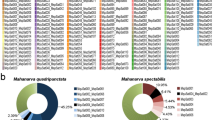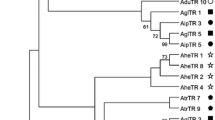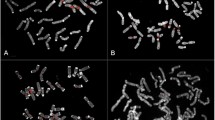Abstract
Satellite DNA repeats (or satDNA) are fast-evolving sequences usually associated with condensed heterochromatin. To test whether the chromosomal organisation of centromeric and non-centromeric satDNA differs in species with holocentric chromosomes, we identified and characterised the major satDNA families in the holocentric Cyperaceae species Rhynchospora ciliata (2n = 10), R. globosa (2n = 50) and R. tenuis (2n = 2x = 4 and 2n = 4x = 8). While conserved centromeric repeats (present in R. ciliata and R. tenuis) revealed linear signals at both chromatids, non-centromeric, species-specific satDNAs formed distinct clusters along the chromosomes. Colocalisation of both repeat types resulted in a ladder-like hybridisation pattern at mitotic chromosomes. In interphase, the centromeric satDNA was dispersed while non-centromeric satDNA clustered and partly colocalised to chromocentres. Despite the banding-like hybridisation patterns of the clustered satDNA, the identification of chromosome pairs was impaired due to the irregular hybridisation patterns of the homologues in R. tenuis and R. ciliata. These differences are probably caused by restricted or impaired meiotic recombination as reported for R. tenuis, or alternatively by complex chromosome rearrangements or unequal condensation of homologous metaphase chromosomes. Thus, holocentricity influences the chromosomal organisation leading to differences in the distribution patterns and condensation dynamics of centromeric and non-centromeric satDNA.







Similar content being viewed by others
References
Barros e Silva AE, Marques A, dos Santos KGB, Guerra M (2010) The evolution of CMA bands in Citrus and related genera. Chromosom Res 18:503–514. doi:10.1007/s10577-010-9130-2
Bureš P, Zedek F, Marková M (2013) Holocentric chromosomes. In: Leitch IJ et al. (eds) Plant genome diversity volume 2, pp. 187–208
Cabral G, Marques A, Schubert V, Pedrosa-Harand A, Schlögelholfer (2014) Chiasmatic and achiasmatic inverted meiosis of plants with holocentric chromosomes. Nat Commun 5:5070. doi:10.1038/ncomms6070
Carvalho CR, Saraiva LS (1993) An air dry technique for maize chromosomes without enzymatic maceration. Biotech Histochem 68:142–145
Čížková J, Hřibová E, Humplíková L, Christelová P, Suchánková P, Doležel J (2013) Molecular analysis and genomic organization of major DNA satellites in banana (Musa spp.). PLoS One 8:54808. doi:10.1371/journal.pone.0054808
Doležel J, Greilhuber J, Suda J (2007) Estimation of nuclear DNA content in plants using flow cytometry. Nat Protoc 2:2233–2244. doi:10.1038/nprot.2007.310
Ferreira J, Mendes S, Dall’agnol M, Sandal N, Sato S, Pedrosa-Harand A (2012) Comparative analyses in Lotus: the cytogenetic map of Lotus uliginosus Schkuhr. Cytogenet Genome Res 137:42–49. doi:10.1159/000339617
Fonsêca A, Ferreira J, Santos TRB, Mosiolek M, Belluci E, Kami J, Gepts P, Geffroy V, Schweizer D, Santos KGB, Pedrosa-Harand A (2010) Cytogenetic map of common bean (Phaseolus vulgaris L.). Chromosom Res 18:487–502. doi:10.1007/s10577-010-9129-8
Gerlach WL, Bedbrook JR (1979) Cloning and characterization of ribosomal RNA genes from wheat and barley. Nucl Acid Res 7:1869–1885
Guarrido-Ramos MA (2015) Satellite DNA in plants: more than just rubbish. Cytogenet Genome Res 146:153–170. doi:10.1159/000437008
Guenatri M, Bailly D, Maison C, Almouzni G (2004) Mouse centric and pericentric satellite repeats form distinct functional heterochromatin. J Cell Biol 166:493–505
Guerra M, Garcia MA (2004) Heterochromatin and rDNA site distribution in the holocentric chromosomes of Cuscuta approximata Bab. (Convolvulaceae). Genome 47:134–140
Haizel T, Lim YK, Leitch AR, Moore G (2005) Molecular analysis of holocentric centromeres of Luzula species. Cytogenet Gen Res 109:134–143
Heckmann S, Macas J, Kumke K, Fuchs J, Schubert V, Ma L, Novak P, Neumann P, Taudien S, Platzer M, Houben A (2013) The holocentric species Luzula elegans shows an interplay between centromere and large-scale genome organization. Plant J 73:555–565. doi:10.1111/tpj.12054
Heckmann S, Jankowska M, Schubert V, Kumke K, Ma W, Houben A (2014) Alternative meiotic chromatid segregation in the holocentric plant Luzula elegans. Nat Commun 5:4979. doi:10.1038/ncomms5979
Hembelen V, Kovarik A, Torrez-Ruiz RA, Volkov RA, Beridze T (2007) Plant highly repeated satellite DNA: molecular evolution, distribution and use for identification of hybrids. Syst Biodivers 5:277–289
Hobza R, Kubat Z, Cegan R, Jesionek W, Vyskot B, Kejnovsky E (2015) Impact of repetitive DNA on sex chromosome evolution in plants. Chromosom Res 23:561–570. doi:10.1007/s10577-015-9496-2
Huang J, Ma L, Yang F, Fei S, Li L (2008) 45S rDNA regions are chromosome fragile sites expressed as gaps in vitro on metaphase chromosomes of root-tip meristematic cells in Lolium spp. PLoS One 3:e2167. doi:10.1371/journal.pone.0002167
Ishii T, Sunamura N, Matsumoto A, Eltayeb AE, Tsujimoto H (2015) Preferential recruitment of the maternal centromere-specific histone H3 (CENH3) in oat (Avena sativa L.) × pearl millet (Pennisetum glaucum L.) hybrid embryos. Chromosom Res 23:709–718. doi:10.1007/s10577-015-9477-5
Loureiro J, Rodriguez E, Dolezel J, Santos C (2007) Two new nuclear isolation buffers for plant DNA flow cytometry: a test with 37 species. Ann Bot 100:875–888
Macas J, Mészáros T, Nouzóva M (2002) PlantSat: a specialised database for plant satellite repeats. Bioinformatics 18:28–35
Macas J, Neumann P, Novak P, Jiang J (2010) Global sequence characterization of rice centromeric satellite based on oligomer frequency analysis in large-scale sequencing data. Bioinformatics 26:2101–2108. doi:10.1093/bioinformatics/btq343
Macgregor HC (2012) Chromomeres revisited. Chromosom Res 20:911–924. doi:10.1007/s10577-012-9310-3
Mandrioli M, Manicardi GC, Marec F (2003) Cytogenetic and molecular characterization of the MBSAT1 satellite DNA in holokinetic chromosomes of the cabbage moth, Mamestra brassicae (Lepidoptera). Chromosom Res 11:51–56
Marques A, Ribeiro T, Neumann P, Macas J, Novak P, Schubert V, Pellino M, Fuchs MW, Kuhlmann M, Brandt R, Vanzela ALL, Besada T, Simkova H, Pedrosa-Harand A, Houben A (2015) Holocentromeres in Rhynchospora are associated with genome-wide centromere-specific repeat arrays interspersed amongst euchromatin. PNAS 112:13633. doi:10.1073/pnas.1512255112
Melters DP, Paliulis LV, Korf IF, Chan SWL (2012) Holocentric chromosomes: convergent evolution, meiotic adaptations, and genomic analysis. Chromosom Res 20:579–593. doi:10.1007/s10577-012-9292-1
Melters DP, Bradnam KR, Young HA, Telis N, May MR, Ruby JG, Sebra R, Peluso P, Eid J, Rank D, Garcia JF, DeRisi JL, Smith T, Tobias C, Ross-Ibarra J, Korf I, Chan SWL (2013) Comparative analysis of tandem repeats from hundreds of species reveals unique insights into centromere evolution. Genome Biol 14:R10. doi:10.1186/gb-2013-14-1-r10
Morgan GT (2002) Lampbrush chromosomes and associated bodies: new insights into principles of nuclear structure and function. Chromosom Res 10:177–200
Neumann P, Navrátilova A, Schroeder-Reiter E, Koblížková A, Steinbauerová V, Chocholová E, Novák P, Wanner G, Macas J (2012) Stretching the rules: monocentric chromosomes with multiple centromere domains. PLoS Genet 8:e1002777. doi:10.1371/journal.pgen.1002777
Neumann P, Schubert V, Fuková I, Manning JE, Houben A, Macas J (2016) Epigenetic histone marks of extended meta-polycentric centromeres of Lathyrus and Pisum chromosomes. Front Plant Sci 7:234. doi:10.3389/fpls.2016.00234
Novak P, Neumann P, Macas J (2010) Graph-based clustering and characterization of repetitive sequences in next-generation sequencing data. BMC Bioinformatics 11:378. doi:10.1186/1471-2105-11-378
Novak P, Neumann P, Pech J, Steinhaisl J, Macas J (2013) RepeatExplorer: a galaxy-based web server for genome-wide characterization of eukaryotic repetitive elements from next-generation sequence reads. Bioinformatics 29:792–793. doi:10.1093/bioinformatics/btt054
Oboerdoerffer P, Sinclair DA (2007) The role of nuclear architecture in genomic instability and ageing. Nat Rev Mol Cell Biol 8:692–702
Pedrosa-Harand A, de Almeida CC, Mosiolek M, Blair MW, Schweizer D, Guerra M (2006) Extensive ribosomal DNA amplification during Andean common bean (Phaseolus vulgaris L.) evolution. Theor Appl Genet 112:924–933
Rosato M, Galián JA, Rosselló JA (2012) Amplification, contraction and genomic spread of a satellite DNA family (E180) in Medicago (Fabaceae) and allied genera. Ann Bot 109:773–782. doi:10.1093/aob/mcr309
Schmidt T, Heslop-Harrison JS (1998) Genomes, genes and junk: the large scale organization of plant genomes. Trends Plant Sci 3:195–199
Schubert V, Ruban A, Houben A (2016) Chromatin ring formation at plant centromeres. Front Plant Sci 7:28. doi:10.3389/fpls.2016.00028
Sonnhammer ELL, Durbin R (1996) A dot-matrix program with dynamic threshold control suited for genomic DNA and protein sequence analysis. Gene 167:1–10
Sousa A, Barros e Silva AE, Cuadrado A, Loarce Y, Alves MV, Guerra M (2011) Distribution of 5S and 45S rDNA sites in plants with holokinetic chromosomes and the “chromosome field” hypothesis. Micron 42:625–631. doi:10.1016/j.micron.2011.03.002
Tek AL, Song T, Macas J, Jiang J (2005) Sobo, a recently amplified satellite repeat of potato, and its implications for the origin of tandemly repeated sequences. Genetica 170:1231–1238. doi:10.1534/genetics.105.041087
Urdampilleta JD, de Souza AP, Schneider DR, Vanzela AL, Ferrucci MS, Martins ER (2009) Molecular and cytogenetic characterization of an AT-rich satellite DNA family in Urvillea chacoensis Hunz. (Paullinieae, Sapindaceae). Genetica 136:171–177. doi:10.1007/s10709-008-9332-0
Vanzela ALL, Guerra M (2000) Heterochromatin differentiation in holocentric chromosomes of Rhynchospora (Cyperaceae). Genet Mol Biol 23:453–456
Wanner G, Schroeder-Reiter E, Ma W, Houben A, Schubert V (2015) The ultrastructure of mono- and holocentric plant centromeres: an immunological investigation by structured illumination microscopy and scanning electron microscopy. Chromosoma 125:503–517. doi:10.1007/s004-015-0521-1
Weisshart K, Fuchs J, Schubert V (2016) Structured illumination microscopy (SIM) and photoactivated localization microscopy (PALM) to analyze the the abundance and distribution of RNA polymerase II molecules in flow-sorted Arabidopsis nuclei. Bio-protocol 6, www.bio-protocol.org/el1725
Weiss-Schneeweiss H, Leitch AR, McCann J, Jang T-S, Macas J (2015) Employing next generation sequencing to explore the repeat landscape of the plant genome. Hörandl E, Appelhans MS (eds). Next-generation sequencing in plant systematics. Chapter 5, International Association for Plant Taxonomy (IAPT). doi:10.14630/000006
Acknowledgements
We thank the Brazilian agency Coordenação de Aperfeiçoamento de Pessoal de Nível Superior (CAPES) for scholarships to T. Ribeiro and A. Marques and for the Special Visiting Research grant to A. Houben, the Brazilian agency Conselho Nacional de Desenvolvimento Científico e Tecnológico (CNPq) for the financial support to A. Pedrosa-Harand and the Czech Science Foundation (BP501/12/G090) for the financial support to J. Macas. In addition, we would like to thank A. Himmelbach (Leibniz Institute of Plant Genetics and Crop Plant Research (IPK)) for the generation of NGS data.
Author information
Authors and Affiliations
Corresponding author
Ethics declarations
Conflict of interest
The authors declare that they have no competing interests.
Research involving human participants and/or animals
No research involving human participants or animals was performed.
Electronic supplementary material
Online resource 1
Online resource 1
Online resource 2
(DOC 30 kb)
Online resource 3
Dot-plot analysis showing the complex organisation of satellite repeats RcSAT2, RcSAT20 and RtSAT239 identified in R. ciliata and R. tenuis. (JPEG 468 kb)
Online resource 4
Individual chromosomes of three selected metaphases from different individuals of R. tenuis (2n = 4x = 8), showing the contrasting labelling pattern of the RtSAT239 repeat between homologous chromosomes. Arrowheads indicate partial decondensation of RtSAT239 in metaphase chromosomes forming chromatin loops. Bar = 5 μm. (JPEG 590 kb)
Online resource 5
Comparative banding pattern for repeats RcSAT2 and RcSAT20 (a, b) or 45S rDNA (c) in R. ciliata. In (b), chromosomes were organised in two groups based on the number of RcSAT2 signals: left (up to four major clusters) and right (more than four clusters). (JPEG 1545 kb)
Movie 1
Arrangement of RgSAT1/1 (red) and RgSAT1/2 (green) superimposed to total DNA (blue) in a root interphase nucleus of R. globosa. Both subfamilies colocolise complementarily to the chromocentres and form globular or ring-like structures. (AVI 14195 kb)
Rights and permissions
About this article
Cite this article
Ribeiro, T., Marques, A., Novák, P. et al. Centromeric and non-centromeric satellite DNA organisation differs in holocentric Rhynchospora species. Chromosoma 126, 325–335 (2017). https://doi.org/10.1007/s00412-016-0616-3
Received:
Revised:
Accepted:
Published:
Issue Date:
DOI: https://doi.org/10.1007/s00412-016-0616-3




